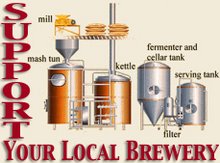Homebrew permit saw rise in final year
Last year, when the requirement was in its death spiral thanks to legislation moving through Trenton, there was a spike in the number of homebrewing permits issued by the state Division of Alcoholic Beverage Control, the agency that regulates all things dram in New Jersey.
From Jan. 1, 2011, to the last day of December, ABC issued 633 permits to make homebrew. That's more than twice the number issued for 2009, when ABC granted 299 permits, and 213 more than the year before (for 2010, the number was 420).
With the stroke of a pen on Jan. 9, 2012, Gov. Chris Christie turned the permit obligation into a footnote, freeing homebrewers from a near-paper tiger mandate that nearly all of them had been ignoring to begin with.
True to form, when word of the permit's demise got out, homebrewers didn't exactly take to the streets singing "Ding, dong, the witch is dead!" It was more like they yawned, and said, "Meh."
 |
| Click to enlarge |
Like a lot of things surrounding craft beer, homebrewing is riding a wave of popularity, too.
The American Homebrewers Association, the national group that supports the hobby and sponsors Big Brew/National Homebrew Day, says its membership has crossed the 30,000 mark, a milestone for the organization that sprang from the 1978 legalization (technically, it's a federal tax exemption) of making beer at home.
The AHA also estimates that these days there are 1 million homebrewers in the United States and more than 1,000 homebrew clubs.
Big Brew this year will be observed on May 5, with homebrewers striking mashes simultaneously (or close to that) across the country, brewing from AHA-provided recipes (this year it's brown ale) or their own.
But the reality is, the event is a show of solidarity and camaraderie around the craft of making beer.
In New Jersey, there's an extra reason on Homebrew Day to raise glasses in a toast: Even though Gov. Christie's eliminating the permit obligation may seem like some pro-forma going through the motions, it does provide some relevant cover for those who enjoy making and sharing their creations. New Jersey homebrewers can indeed say, "Ding, dong, that witch is dead."
Homebrew Competitions
The Tun Tavern is once again holding a pro-am homebrew competition, and Cricket Hill Brewing was planning another one toward the fall.
The entry deadline for the Tun Tavern's contest is Tuesday, May 1. And yeah, that's less than a month away, but this competition was announced weeks ago on homebrew forums, such as the Barley Legal Homebrewers, so consider this note a reminder. If you live in North Jersey, don't let the fact that this is in South Jersey keep you from entering. Well-made beer always wins.
Entries should be comprised of a six-pack or the equivalent of whatever style you're submitting, plus your contact information (email, cell phone number, land line ... just make it so you can be reached.)
Grand prize is a chance to scale up your winning recipe and brew a batch that will be served at the Tun's booth at the Garden State Craft Brewers Guild Festival, June 23 aboard the battleship USS New Jersey at the Delaware River waterfront in Camden. The prize also includes passes to the festival. The Tun's phone number is 609-347-7800.
As far as Cricket Hill's contest goes, we caught up with brewery co-owner Rick Reed at a Friday night tour and asked if they planned to hold another competition. If you remember, it was a homebrew competition that produced CH's nicely done Russian imperial stout, plus an IPA the brewery released just a couple weeks ago.
Rick says they plan to hold another contest, some time around or after August. Best bet is to mark your calendar and check with the brewery toward the end of July to see if their plans hatched in early spring are is the same in late summer.































































